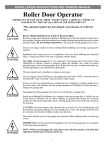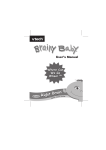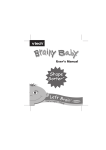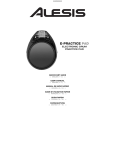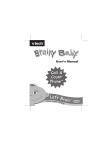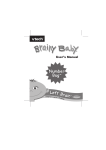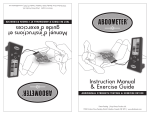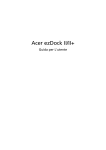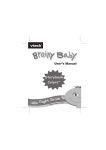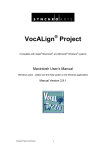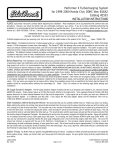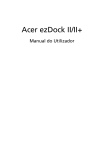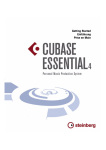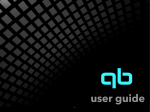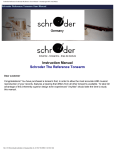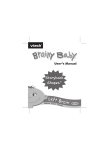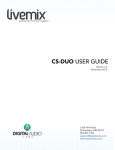Download Groove Agent 4.2_VersionHistory_Known_issues
Transcript
Groove Agent 4 Version history Known issues & solutions Januar 2015 Steinberg M edia Technologies Gm bH Table of contents Table of contents .................................................................................................................. 2 About ........................................................................................................................................ 3 Groove Agent 4.2.0................................................................................................................ 4 New features ............................................................................................................................... 4 Last minute changes ................................................................................................................. 4 Known Issues........................................................................................................................... 13 Improvements & issues resolved ......................................................................................... 14 Groove Agent 4.0.0.............................................................................................................. 17 Issues & solutions ................................................................................................................... 17 Credit notice: Steinberg, Cubase, Groove Agent, ASIO and VST are registered trademarks of Steinberg Media Technologies GmbH. VST Sound is a trademark of Steinberg Media Technologies GmbH. Windows is a registered trademark of Microsoft Corporation in the United States and other countries. Macintosh, Mac and Mac OS are trademarks of Apple Inc., registered in the U.S. and other countries. All other product and company names are trademarks and registered trademarks of their respective holders. All specifications are subject to change without notice. Made in Germany. Copyright © 2014 Steinberg Media Technologies GmbH. All rights reserved. Version history: Known issues and solutions Page 2 Steinberg Media Technologies GmbH About Congra tula tions and thank you for using Groove Agent! This document lists all update changes and improvements as well as known issues and solutions for Groove Agent 4. Enjoy using Groove Agent! Your Steinberg Team Version history: Known issues and solutions Page 3 Steinberg Media Technologies GmbH Groove Agent 4.2.0 New features To get an overview of the new features, please take a look at: www.steinberg.net/grooveagent Last minute changes The following features are new in Groove Agent 4.2, however, have yet to be added to the user manual. Pre-listen to MIDI files in the browser The browser now also shows MIDI files, which allows to search for specific MIDI files and to drag and drop them from the browser to a pattern pad. The Pre Listen section below the tree and result list also works for MIDI files. Select a MIDI file and click Play to send the MIDI notes to the currently selected Agent. Click on Pause to interrupt the playback or Stop to end it. Activate the "Auto Play" option to play a MIDI file as soon as you select it in the result list. The pattern switches intelligently, respecting the current playback position of the running MIDI file. The playback also aligns to the tempo of the project and the song position if the host sequencer is running. The info window on the left side gives information about the original tempo, signature and length as stored with the file. Note Repeat Note Repeat allows you to perform a wide variety of phrases from simple note repeats to complex phrases. Each kit comes with its own Note Repeat settings, which enables you to perform simultaneously different instruments of multiple kits on dedicated MIDI channels. Since the output of Note Repeat can be recorded with the internal pattern player, it can also be used to record rhythmic patterns, which would otherwise be difficult to play live. Note Repeat notes are also sent to the MIDI output of Groove Agent, which enables you to even trigger external plug-ins or record the notes in the host sequencer. Note Repeat allows you to define eight different variations which can be triggered either using definable keys on your Version history: Known issues and solutions Page 4 Steinberg Media Technologies GmbH keyboard or MIDI controller messages. This means that you can set up, for example, repeats with different note values like 1/8, 1/16, 1/32, 1/64 and then switch between them in real time. Furthermore, Note Repeat is not only able to generate notes on a note value, but also on milliseconds basis, to create repetitons with a frequency independent from the song tempo. The Note Repeat edit page is divided into two sections. The upper section allows you to create simple note repeats, assign trigger keys and control the general behavior. The lower section provides a phrase editor that can be activated and edited to create complex patterns. Note Repeat variation trigger notes have a higher priority than normal instrument notes, which means that if they share the same key you cannot play the instrument on that key. The internal Pattern Player, however, will correctly trigger the underlying instrument. If a Pattern Pad shares the same trigger note with a Note Repeat variation trigger, then the Pattern Pad will win. This is also reflected on the Pattern Pads. Note Repeat variation trigger keys show a Repeat icon and are colored in pale blueish gray. The same color is also applied to the keys of the plug-in keyboard. By default, triggering Note repeat variations will also switch the editor to the current settings. If you don’t want the editor to follow the played variation, turn off MIDI Follow in the Note Repeat header. Note Repeat comes with its own preset functionality, which allows you to save and restore all its settings or delete existing user presets. You can find the corresponding controls in the caption of the editor page. Additionally, there are copy and paste buttons which can be used to copy all Note Repeat settings from one agent to another. The Note Repea t parameters in detail Active: Activates the note repeat section. Sync (to Bea t): When Sync to Beat is on, repeat notes will always start on the next valid for example, 1/8th, 1/16th, etc. note according to the current song positon. This also means that legato-played note-repeat variation changes will not lead to a restart of the repeat phrase, but continue on their current beat positons. Version history: Known issues and solutions Page 5 Steinberg Media Technologies GmbH With Sync to Beat off, Note Repeat starts immediately, even if the note is not played on the beat and phrases will always be restarted from the beginning. Mono: By default, Note Repeat works on all instruments you trigger simultaneously, which means that if you play for example two notes, both a repeated. By activating Mono you can force the repeat to be played only on the last key you have pressed. Example: Trigger a Note Repeat variation key, hold it and then play a first instrument note and hold it, too. The note will be repeated. Now play a second instrument note in addition. The repeat will continue but will now play the second instrument. Release the second instrument key and the repeat will continue again on the first instrument. With Mono off, the repeat would affect both instruments as long as their keys are held. This means Mono off delivers an additive behavior while Mono on will give you an exclusive one. Note Repea t Varia tions: Click the variation switches 1-8 to play the desired repeat phrase. Right-click a variation switch to open a context menu. Here you can copy and paste the settings from one variation to another. Trigger Source: Here you can decide whether you want to use keys on your keyboard to switch between Note Repeat variations, or MIDI controller messages. If it is set to Key, you can click and drag the text field under the variation button to select the desired MIDI note or you can click in the text field and play the desired note on your keyboard. Confirm with Enter or use the tab key on your computer keyboard to jump to the next variation. Note: Variation Trigger notes can only be used for one variation at a time. If you select a note that is already in use by another variation, a red warning sign appears to inform you about the conflict. When controllers are used as a trigger source, you can specify them again in the text field under the variation key. Clicking a text field opens a list. You can now select one of the controllers and the list will close, or you can simply use the corresponding hardware control on you MIDI keyboard to learn the controller. When working with MIDI controllers, a variation is activated as soon as the controller value exceeds 64. The last controller value higher than 64 decides which variation to play. Version history: Known issues and solutions Page 6 Steinberg Media Technologies GmbH Example: The first variation is assigned to a MIDI controller knob (Controller 107), the second variation to another knob (Controller 108). As soon as the first knob value exceeds 64, the first variation is active. Now turn the second knob and pass the 64 value. The second variation now plays instead. However, the controller value of the first knob is still above 64 and turning this knob again will not switch back to variation 1, unless you move the knob under 64 and back above. Therefore, it is recommended to use MIDI controller switches rather than faders or knobs. In this case, you should define the switches on your remote keyboard, as on/off switches, sending a value of 127 when pressing, and 0 when releasing them. This is the best way to control the variation selection. Key Range: You can limit the key range that is affected by Note Repeat with the Low and High Key controls. Notes outside this range are played normally without any note repeat. This can be used, for example, if you want to use Note Repeat to record complex Hihat patterns in your host sequencer without repeating any already recorded Bass drum or Snare tracks coming from the same kit. Velocity Controller: Here you can decide on how the output velocity of the repeated notes is generated. "Constant (127)" triggers the notes with a fixed velocity of 127. "Velocity" triggers the notes with the velocity of the note you play. The "Controller" submenu allows you to select a MIDI controller. The value of the MIDI controller will be used as velocity for the triggered notes. When "Aftertouch" is the selected, the triggered notes get their velocity from the Aftertouch controller. "Poly Pressure" is similar to Aftertouch, but you can control the velocity per key. Note: Note Repeat will already start to trigger notes by receiving a Poly Pressure value greater 0, even if no MIDI note was triggered in advance. "Fetch": When Aftertouch, Poly Pressure or a MIDI Controller are used to specify the velocity of the note repeat notes, the Fetch option can be used to change the way these notes are generated. With Fetch on, the first note you play will define the initial velocity. As soon as the controller value exceeds this velocity, new notes will get their velocity from the controller. Version history: Known issues and solutions Page 7 Steinberg Media Technologies GmbH With Fetch off, notes are only generated for controller values larger than 0. This means that if you play a note, and the controller has not yet been set to a value larger than 0, no note repeats are generated. Moving the controller value up will then generate note repeats with a velocity of the current controller value. Note: The velocity values of the phrase are always used to modulate the output velocity. So if you want to use only the velocity values of the phrase, set the Velocity controller to "Constant (127)". This way the phrase input velocity is 127 and can be modulated by the phrase steps from 0 to 127. Phra se section Active: Turns the phrase on or off. Phra se: Allows you to select one of the available phrases. Save: Save your phrase to the user phrase library. Delete: Delete a selected phrase from the user library. Copy: Copies the phrase to the clipboard. You can then select another variation and paste the phrase there. Pa ste: Paste the phrase from the clipboard Swing: Use this parameter to shift the timing of notes on even-numbered beats. This way, the pattern gets a swing feeling. Negative values let the notes play earlier, positive values let the notes play later. Defining the Phra se Length: To specify the number of steps for the phrase, drag the phrase length handle to the right or left. Adding and Adjusting Steps The height of a step represents its velocity value. You can edit the steps in the following way: • To activate all steps, select “Enable All Steps” from the context menu. • To adjust a value, click a step and drag up or down. • To adjust multiple steps, click and draw a curve. • To adjust the velocity of all steps relatively, [Shift]-click and drag. • To draw a ramp with steps, hold down [Alt]/[Option] and draw a line. • To draw symmetric ramps at the beginning and the end of the sequence, hold down [Shift]-[Alt]/[Option] and draw a line. Version history: Known issues and solutions Page 8 Steinberg Media Technologies GmbH • To reset the velocity of a step to 127, [Ctrl]/[Command]click the step. • To reset the velocity of all steps to 127, hold [Shift][Ctrl]/[Command] and click a step. Adjusting the Phra se • To reverse the phrase, click the Reverse button. • To duplicate short phrases, click the Duplicate button. The maximum number of steps is 32, therefore, if you copy a phrase that contains more than 16 steps, it cannot be copied entirely. • To shift the rhythm of the phrase, use the arrow buttons in the lower left corner of the edit section. If you shift the rhythm of the phrase to the left, the first step is moved to the end. If you shift the phrase to the right, the last step is moved to the beginning. Using Note Repea t a s a M I D I genera tor to record pa tterns in Cuba se Note repeat can also be used to record complex patterns directly in the host sequencer, either to send them directly back to a Groove Agent Kit or to drive any other plug-in. To do so, you need two kit slots and two sequencer tracks to start. Keep the empty kit on slot 1 since it will only be used to generate note repeat notes. Go to the perform page of kit 1 and activate Note Repeat. On Slot 2, load the Kit you want to use as the "sound generator". Route the first Cubase track to Slot 1 to send notes played on your keyboard to the Note Repeat module of this slot. Set up the desired Note Repeat settings for slot 1. Activate the input monitor on this track. Select the second Cubase track and choose "Groove Agent Kit 1" as MIDI Input. Set the MIDI output to channel 2 to send the notes to Kit 2. Arm Record on the second track. When playing a an instrument key together with a note repeat variation key, the note repeat notes are now generated and can be recorded. Version history: Known issues and solutions Page 9 Steinberg Media Technologies GmbH If you are recording a drum pattern in a loop, you can add different instruments with each cycle using various note repeat variations. Note: It is not recommended to route the recording track back to the kit you are using to generate the note repeat notes because notes that have been recorded with a first cycle will also be affected when Note Repeat is triggered during a following cycle. This means that for the time of the recording all instruments will play the same note repeat phrase. (Even though the already recorded notes are still there and can be played back correctly afterwards). To avoid this behavior, you can limit the range of notes that can be affected by note repeat, to the instrument key or keys you want to add. This can be done by setting low key and high key notes for the note repeat module. However, this requires changing the range with each new cycle and instrument. Working with two slots in comparison, is much more comfortable. In fact, you can also load a second instance of Groove Agent and use it exclusively for generating Note Repeats that can be sent to any other Cubase MIDI track. Individual Pa ttern Pads per Kit Groove Agent 4 initially came with a global Pattern section. All patterns of all Agents played together, when a pattern pads was triggered, a behavior that allowed you to play complex arrangements of multiple Agents with only one key. This feature covered a major use case, however, there was the wish to be able to play the agents with their patterns individually, each on its own MIDI channel. Therefore, Groove Agent 4.2 now optionally allows you to play each Kit with its pattern independently. To use this mode, deactivate the new "G" (Global) button below the Pattern Pad section. (When global is active Groove Agent behaves exactly as before). Being in individual mode, there are some important changes: Each Agent plays its patterns when pattern pads are triggered. Other Agents will not play (except if you set them to the same MIDI channel). By default, the MIDI input channel of the pattern pad section is the same as for the instruments. To separate the control over patterns and instruments, you can use either the "Port P" option, which allows you to control the pattern pads via the secondary MIDI port, or choose a different MIDI channel. (This is especially important for sequencer applications like Logic that don't support multiple MIDI ports per plug-in) Version history: Known issues and solutions Page 10 Steinberg Media Technologies GmbH Example 1: Set Agent 1 in Slot 1 to MIDI channel 1 and activate the Port P option in the pattern pad section. You now have independent control over instruments and patterns, even if they share some trigger notes on the keyboard. Set up two tracks in your sequencer and route them to "Groove Agent - Main", for the instruments and "Groove Agent Pattern" for the pattern pads, each on MIDI channel 1. Set up other agents accordingly on different MIDI channels. In case your sequencer doesn't support the Pattern Port: Example 2: Set Agent 1 in Slot 1 to MIDI channel 1 and the MIDI channel for the pattern pads to 2. You now have independent control over instruments and patterns, even if they share some trigger notes on the keyboard. Set up two tracks in your sequencer and route them to MIDI channel 1, for the instruments and MIDI channel 2, for the pattern pads. For other agents you can then choose different MIDI channels. Agent 2 in Slot 2 could be set to MIDI channel 3 and its pattern section to 4 and so on. Of course you can also keep the default assignment, Agent 1 on MIDI channel 1, Agent 2 on 2,... and set the pattern sections of the four agents to MIDI channel 5, 6, 7 and 8. But that's a question of taste. When loading Kits in individual mode, there's no need to think about Pad colors, names and other Pad settings, they are all individual per kit. That's why there's no need to lock or unlock Pattern pad settings and therefore the lock option is disabled. Switching from Individual Mode to Global Mode When switching from individual mode to global mode, the global pattern pads, at first, have their default pad settings. This means, that the pads have no color, name, or other pad settings, like exclusive for example. You can configure the global pads completely new and independent from the four agent pattern pads. In some cases you might want to use the pattern pads settings of one agent for the global pattern pad settings too. Here you can make use of the copy paste settings functionality which can be found in the context menu on an agent in the kit rack. Switching from Global Mode to Individual Mode When switching from global to individual mode on multi presets created with groove Agent 4.0 , the agent pattern pads have no individual settings yet. Therefore, they global pad settings are automatically copied to the agent pad settings. Version history: Known issues and solutions Page 11 Steinberg Media Technologies GmbH Transferring Pa ttern Pad Settings You can copy and paste pattern pad settings from one agent to another, to the global pattern pads or from the global pattern pads to a specific agent. To copy settings, open the context menu on an agent in the kit rack and select either "Copy Global Pattern Pad Settings" or "Copy Kit Pattern Pad Settings", depending on what you want to copy. Then open the context menu again on the agent on which you want to insert the settings, and select "Paste To Kit Pattern Pad Settings" or select "Paste To Global Pattern Pad Settings if you don't want to paste it on an individual agent but on the global pattern pads. Playing pa tterns using the transport controls In individual mode, each agent has its own transport controls. This means that you can select a pattern pad on one agent and then press play to play the pattern, but other agents will not play. You can then switch over to another agent, select a pad here and press play again. The second agent will start to play based on the current position of the already running agent (Sync to Beat is on). Pressing Stop will stop only the current agent. Note: If you want to start or stop playback for all agents simultaneously, shift-click the Play or Stop button. The same is true for "Follow Transport". Activate the option on one Agent and it will follow the start/stop commands and time position of your host sequencer. Other agents can be set to Follow Transport off and will not follow. You can still manually control their playback using Groove Agent’s transport controls. Note: If you want to activate/deactivate Follow Transport for all agents simultaneously, shift-click the Follow Transport button. Playing pa tterns in Jam Mode Just as in normal mode, also Jam Mode works independently for each agent. If you activate Jam Mode for multiple agents you can jam on all of them. Example: Load two kits on two slots and activate Jam mode on the first kit. The Play button starts blinking. As soon as you trigger a pattern pad, it starts to play. Now switch over to the second kit and activate jam mode here too. Like for the first kit, the play button starts blinking and waits for a pattern to be triggered. Trigger a pad and it will join the first one at Version history: Known issues and solutions Page 12 Steinberg Media Technologies GmbH the current play position. You can now freely switch between the two running agents and switch pattern pads. Note: If you want to activate/deactivate Jam Mode for all agents simultaneously, shift-click the Jam Mode button. Media Bay The search columns now only show tags that are available depending on the specified filters. The previous version showed all tags, even if they would not lead to any result when selected. Pa ttern Editor Ctrl-click with the drumstick tool deactivates the snap to grid functionality temporarily, so that notes can be positioned freely. Known Issues M I D I Output Recording Groove Agent’s MIDI outputs can only be recorded in host applications that support plug-in MIDI outs. Currently AU hosts like Logic, Digital Perfomer or Live do not support this feature. (AU was falsely mentioned in the Groove Agent manual) Sonar X3 MIDI output recording is not working for the VST 3 version. This is a bug in Sonar and will be fixed with an upcoming update. Please use the VST 2 version instead. Studio One: Currently Studio One isn't able to correctly record the MIDI output of Groove Agent, since Note Off messages sent by Groove Agent are interpreted as Note On messages with a velocity of 0. A future Studio One update should fix the problem. Fruity Loops Fruity Loops 11 provides a number of additional context menu entries (for example, "Link to Controller") when rightclicking a control. Selecting one of these entries lead to a state, where Groove Agent doesn't respond anymore. This is a Fruity Loops bug which will be fixed with a future Fruity Loops update. Until the fixe has been delivered, only select menu entries provided by Groove Agent. Version history: Known issues and solutions Page 13 Steinberg Media Technologies GmbH Ableton Live under Mac 10.10 To open a sub preset or MIDI file selector, you need to click the triangle icon button slowly, otherwise, if you click to fast, the dialog opens and closes directly again. Improvements & issues resolved The following table lists all issues that have been resolved and the improvements in this version. ID # Issue 3367 Miscellaneous: Browser can now filter for MIDI files only 3464 Miscellaneous: Buttons for MIDI Follow and Select Layers via Velocity are now restored with a project 3317 Miscellaneous: Saving and loading of the plug-in default settings now works as expected 3432 Miscellaneous: The MIDI file selector has been optimized to handle a large number of MIDI files in the user folder 3379 Miscellaneous: Jam Mode On/Off is now restored with a project 3214 Miscellaneous: Key command assignment optimized for page section 3142 Miscellaneous: Ctrl-A can now be used to select all nodes in the envelope editors 3095 Miscellaneous: Activating "Port B" now updates Cubase drum maps 3167 Miscellaneous: VU meter in kit mixer no longer displays signal levels when corresponding kit slot is muted 3022 Miscellaneous: The song position display is no longer out of sync when using a Cubase tempo track 3283 Effects: Tube Compressor now updates immediately if you adjust parameters without audio running 3158 Effects: The tube and vintage compressors now update the release time soundwise when you switch Auto Release off 3073 Effects: An automated Tube Saturator no longer leads to unwanted distortion Version history: Known issues and solutions Page 14 Steinberg Media Technologies GmbH 3385 MediaBay: Dropping a program from the MediaBay to a slot switches to the newly loaded kit 3409 MediaBay: "Switch off all Pattern Players" doesn't switch off all MIDI inputs 3322 MediaBay: MIDI note are now correctly triggered when they are duplicated via [alt] + drag before 2969 MediaBay: Delete and backspace now work in "Load Multi Dialog" 3168 MediaBay: Signature column has been added to the default MediaBay view 3165 MediaBay: "Signature" filter in MediaBay is now working correctly 3435 Pattern Editor: Poly pressure can be recorded 3250 Pattern Editor: Pattern Editor zooms out if the value for the "End Beat" is increased 3363 Pattern Editor: End marker of pattern in pattern editor doesn't disappear after moving it to the right 3438 Pattern Editor: After trimming a pattern the zoom level is now correct 3449 Pattern Editor: Changing pattern length no longer leads to wrong locator positions 3075 Pattern Editor: With selecting "Show Keys with Events", switching between patterns updates correctly 3433 Pattern Editor: Tool now changes automatically to pen when moving to controller lane 3384 Pattern Editor: The play marker in the slice editor now runs with the correct position if the sample is trimmed 2846 Pattern Editor: Duplicate Pattern behaves now the same way in play and record mode 3219 Pattern Editor: When switching MIDI patterns to half-tempo, patterns are now correctly played 3019 Pattern Editor: Events drawn with drumstick are corrcetly displayed when "Show Note Length" and "Snap To Grid" options are activated 2970 Pattern Editor: Pattern recording takes half-time/double-time tempo correctly into account 3020 Pattern Editor: Dragging and dropping notes in the Pattern Editor during playback with "Auto-Scroll" on now works correctly Version history: Known issues and solutions Page 15 Steinberg Media Technologies GmbH 2968 Pattern Editor: The note preview option in the pattern editor only affects editing notes. Clicking the key in the key column will always play the instrument 2953 Pattern Editor: When changing the length of a pattern by typing in a new end value, the zoom level and scroll position are now updated. An update is also done, when executing a trim or duplicate pattern operation 3412 Pattern Pads: Loading pattern groups now creates only one undo step 3087 Pattern Pads: Multiple MIDI files can now be added per drag and drop to Pattern Pads 3389 Pattern Pads: LEDs which indicate if Pattern Pads are assigned now are turned off when removing all kits 3352 Pattern Pads: Percussion pattern groups can now only be loaded on Percussion Agent not on other Agents 3282 Pattern Pads: Tempo scale and swing can now be assigned to individual MIDI controllers 3259 Pattern Pads: The pattern MIDI channel is now restored from Cakewalk Sonar X3 projects 3245 Sample Editor: Fade handles in the sample editor can be resetted to default by CTRL-click (CMD-click) 3153 Sample Editor: The release loop is by default always set to "No Loop" 3458 Slice Editor: Full zoom in Slice Editor after trimming a slice is now possible 3423 Slice Editor: Trimming samples of a sliced loop no longer leads to grayed out slices 3422 Slice Editor: Slices markers can now be moved, if neighbouring slices are trimmed 3383 Slice Editor: The Classifier delivers better results for trimmed samples Version history: Known issues and solutions Page 16 Steinberg Media Technologies GmbH Groove Agent 4.0.0 July 2014 Initial release. To get an overview of the new features, please take a look at: www.steinberg.net/grooveagent Issues & solutions 32-bit OS and memory Since 32-bit operating systems can only handle a limited amount of memory it is recommended to set “Load Preference” on the options page to 16-bit. This will force Groove Agent to load Acoustic and Percussion Agent kits in their 16-bit versions, which consume less memory for sample preload. This increases the memory headroom for parallel kits and other plug-ins. To reduce memory usage further, you can also limit the number of undo steps on the options page in the global section. By default, the setting is set to 10. Some hosts do not support additional plug-in MIDI ports In this case, the “Use MIDI Port B for Pattern Pads” option in the pattern pads section cannot be used. Instrument and pattern pads have to share the same keys. Since pattern pads always have priority, instrument pads using the same trigger note, cannot be played directly. There are two ways to solve the problem. 1. Move the pattern pads to other pattern pads that do not share trigger notes with instrument pads. 2. Deactivate the pattern pad. Now the instrument can be played again. Keep in mind that exported patterns played from the host sequencer may also contain notes that trigger pattern pads themselves. To avoid this, deactivate these pattern pads individually or bypass all the pattern players globally with the “Switch off All Pattern Players” option that can be found on the main toolbar. Version history: Known issues and solutions Page 17 Steinberg Media Technologies GmbH Exporting MIDI percussion style files to Sonar X3 When exporting percussion styles to Sonar, the MIDI clips may contain notes on different MIDI channels. Select a specific MIDI channel for the track to route all events to the same MIDI channel set in the corresponding Groove Agent slot. MIDI controllers in Sonar X3 Sonar currently does not support the number of exported parameters by Groove Agent, so MIDI controller parameters are disabled by default. In general, you can enable/disable the export of MIDI controller parameters from the VST 3 plug-in for a specific application by adding the following item to the “Entries” list in the default.xml file found in your plug-in preference folder: <item> <string name="Group" value="ExportMidiParameters"/> <member name="Values"> <int name="Sequencer" value="0"/> </member> </item> Replace “Sequencer” with the name of the host application. It is displayed in the bottom line of of Groove Agent’s About box. To re-enable MIDI controller parameters for a future Sonar version, the appropriate line would be: <int name="Sonar X3 Producer" value="1"/> Please note that you have to edit defaults.xml while the plugin is not loaded, otherwise your changes will be overwritten. Automation in Sonar X3 User-defined automation channels are not correctly restored when loading projects using Groove Agent VST 3. Use the VST 2 version instead. Automation and controllers in Fruity Loops When loading projects, user automation parameters are not correctly reconnected. Use the VST 2 version instead until this issue is fixed in Fruity Loops. Version history: Known issues and solutions Page 18 Steinberg Media Technologies GmbH Automation in Ableton Live When an automation parameter names change within Groove Agent, automation may be disabled in Live and the “Re-Enable Automation” button at the top turns on. Press it to reconnect automation parameters. The button does not turn on if this happens while restoring a project. However, “Re-Enable Automation” can still be used to fix unconnected automation parameters. Version history: Known issues and solutions Page 19 Steinberg Media Technologies GmbH



















